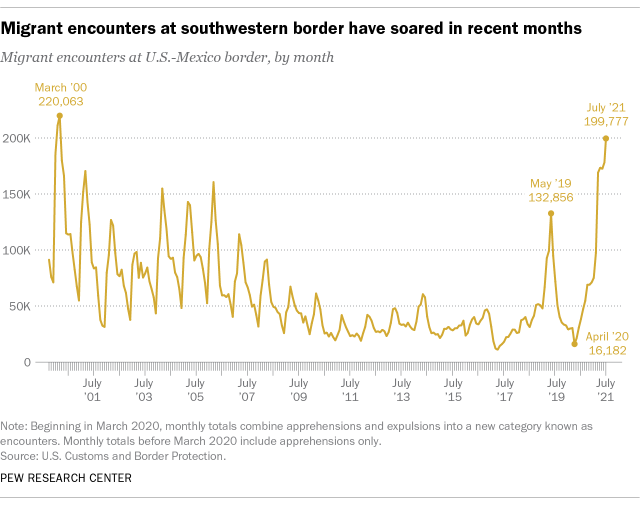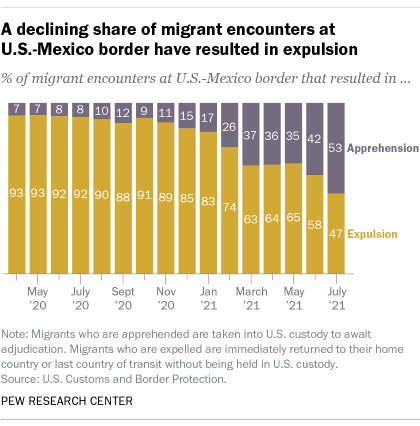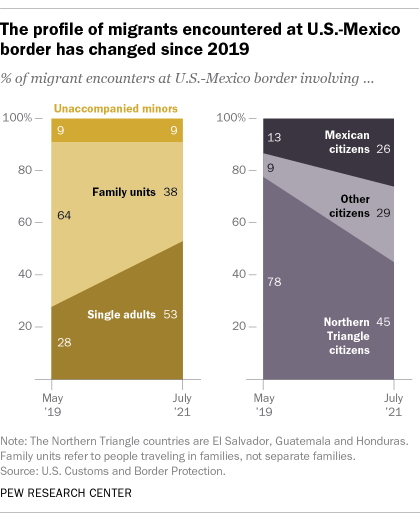The U.S. Border Patrol reported nearly 200,000 encounters with migrants along the U.S.-Mexico border in July, the highest monthly total in more than two decades.
The number of monthly encounters had fallen to 16,182 in April 2020, shortly after the coronavirus outbreak forced the closure of the southwestern border and slowed migration across much of the world. But migrant encounters have climbed sharply since then, reaching 199,777 in July, according to the latest data from U.S. Customs and Border Protection (CBP), the federal agency that encompasses the Border Patrol.
The July figure is the highest monthly total since March 2000 and far surpasses the peak during the last major wave of migration at the U.S.-Mexico border, which occurred in May 2019.
This analysis examines current and historical data from U.S. Customs and Border Protection (CBP) to assess how migration patterns at the U.S.-Mexico border have evolved over time. The analysis is based on monthly migrant encounters – a common (but only partial) measure of how many people enter the United States illegally in a given month.
Encounters encompass two distinct kinds of events: apprehensions, in which migrants are taken into custody in the U.S. to await adjudication, and expulsions, in which migrants are immediately expelled to their home country or last country of transit without being held in U.S. custody. CBP began publishing data on migrant encounters in March 2020, when expulsions began under a public health order called Title 42. In this analysis, all references to migrant encounters prior to March 2020 refer to apprehensions only.
It is important to note that encounters refer to events, not people, and that some migrants are encountered more than once. In fact, a growing proportion of encounters in recent months have involved repeat border crossers. As a result, the overall number of encounters reported in a given month may overstate the number of distinct individuals involved.
This analysis only includes monthly encounters reported by the Border Patrol. It excludes encounters reported by the Office of Field Operations.
Migrant encounters refer to two distinct kinds of events: apprehensions, in which migrants are taken into custody in the United States to await adjudication, and expulsions, in which migrants are immediately expelled to their home country or last country of transit without being held in U.S. custody.
Most encounters that have occurred in recent months have resulted in expulsion, not apprehension, under a public health order known as Title 42. President Donald Trump’s administration invoked Title 42 in March 2020, arguing that it would slow the domestic spread of the coronavirus by expelling migrants rather than holding them in close quarters in U.S. immigration facilities. Between April 2020 and the end of the Trump administration, more than 80% of monthly migrant encounters at the southwestern border resulted in expulsion rather than apprehension.
Expulsions have become less common – and apprehensions more common – in the first months of President Joe Biden’s administration. In July, 47% of migrant encounters resulted in expulsion, down from 83% in January, when Biden took office. During the same period, the share of migrant encounters that resulted in apprehension rose from 17% to 53%.
Despite this shift, the Biden administration announced this month that it would allow Title 42 expulsions to continue, given the current increase in migration and the threat posed by the delta variant of the coronavirus. The administration is also reportedly preparing to offer coronavirus vaccines to migrants who are apprehended and held in U.S. custody.
One apparent consequence of the expulsions carried out under Title 42 has been an increase in repeat border crossers. In July, 27% of border encounters involved migrants with at least one previous encounter within the past year, according to CBP statistics. That was up from an average of 14% between the 2014 and 2019 fiscal years, before Title 42 took effect.
Single adults drive recent increase in migrant encounters
The migrants being encountered at the U.S.-Mexico border today differ demographically from those encountered during the last major increase in southwest migration, in May 2019.
Single adults accounted for 53% of migrant encounters in July, up from 28% in May 2019, while people traveling in families represented 38%, down from 64%. The share of encounters involving unaccompanied minors was unchanged at 9%.
Migrants’ origin countries have also shifted since May 2019, with Mexican nationals accounting for a larger share of encounters and people from the Northern Triangle countries – El Salvador, Guatemala and Honduras – representing a smaller share. In July, 26% of migrant encounters involved Mexican citizens, up from 13% in May 2019. People from the Northern Triangle countries accounted for 45% of encounters in July, down from 78% in May 2019.
Migration from countries other than Mexico and the Northern Triangle has also increased in recent months. Around three-in-ten encounters in July (29%) involved migrants from other countries, up from 9% in May 2019.
Note: This post was originally published on March 15, 2021. It was updated on Aug. 10, 2021, and again on Aug. 13, 2021, to reflect the most recent available data.





